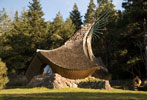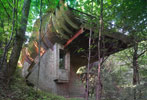|
    
The term "Organic Architecture" was made famous when Frank Lloyd Wright
used it to describe his particular approach to architecture. Yet, the
word "organic" itself was never fundamentally important in the
definition of the term. In fact, when discussing the meaning of the word
organic in the 1950s, Wright mused that had he wanted to give his
approach to architecture a name at that point in time, he would have
perhaps used the term "Bionic Architecture". The interchangeability of
the word "organic" suggests that Wright knew full well the importance of
having simple identifiable slogan that represented his architectural
philosophy. The fact that he identified the word "Bionic", which was
gaining popularity in both science and science fiction at that time,
indicates that he was probably conscious of choosing a phrase that while
embodying his architectural message, also positioned himself at the
forefront of pop culture.
Despite the insignificance of the word "organic", the term "Organic
Architecture" is still representative of a certain attitude to
architectural design: an attitude that was held by Wright, and a series
of architects that have followed him.
The problem with the word "organic" is that in its contemporary usage,
it implies meanings that are incorrect of the original definition of
Organic Architecture.
Probably the most common misconception is the belief that Organic
Architecture is curved and free form. I find it confounding when I read
explanations that cite Frank Lloyd Wright as a practitioner of organic
architecture, then go on to say that Organic buildings are curvilinear.
Wright's buildings are very seldom curved, and are certainly never free
form. Where he does use curves, he uses circles, which are obviously
governed by a strict geometry.
Another common misconception is that Organic Architecture is inherently
environmentally sustainable. While being environmentally sustainable is
important to Organic architects, it should be integral to all
architectural design, Organic or not, and thus really cannot be
considered as a defining characteristic.
Organic architecture stems from a reverence of the natural environment
and an understanding that the wellbeing of the human psyche cannot be
nurtured by removing people from the natural world in which they belong.
To this end, Organic buildings grow from the ground as one with their
site, but they also provide occupants a connection to the exterior
environment.
Organic architecture is not a stylistic or aesthetic movement. Each
building is a response to its program, the character of its occupants,
the time in which it is designed, the conditions and the qualities of
its site. Because each of these conditions will never be identical, each
Organic building will be unique. However, because the intent to create
buildings that are at one with their site and that allow for connections
to the exterior is a fundamental philosophy shared in all Organic
Architecture, there are a few common characteristics.
Geometry
In spite of the popular belief that free forms are natural, nature is
not free form. It is predictable and comprehensible. It is governed by
rules and patterns, and it is by understanding these rules that people
feel comfortable in their environments. Organic architecture utilizes
strong, rational geometry to create a comprehensible building that can
be understood as a single entity.
Materials
To enhance the connection of the interior to the natural environment,
natural materials such as stone and wood are commonly utilized in
Organic architecture. Because large slick surfaces feel inherently
artificial, where they are necessary, they are often given textures or
applied with patterns to break up the surface.
Mass
In order to break down the sense of enclosure, Organic architecture
often is composed of recognizable, individual masses (see Box Theory ),
that due to their arrangement form a shelter. This differs from the
typical method of creating architecture by using surfaces or envelopes
to form the interior space.
Glass
The way glass is used is critical part of organic architecture. Glass
provides views to the natural environment, but also breaks up the forms
of the building. This reduces the building into its individual masses,
and breaks the sense of enclosure. Where glass is used, it is important
that the materials are carried through, from the interior to the
exterior, and that the glass itself has a minimum visual impact.
The Site
Organic Architecture is always informed through a response to its site.
Wright said that the building should be "of the hill" and not "on the
hill". In this way organic architecture should nestle itself into its
site and weave around the existing trees.
This web site was intended as a resource for those interested in Organic
Architecture. It contains a collection of photographs and descriptions
of organic buildings that I have been able to visit and photograph. The
projects are listed by architect, and then by chronological order. You
may click on the thumbnail images on the right to bring up additional
photos of each project. I have personally found online sources for
Organic architecture lacking, and hope that my contribution can provide
a useful addition to the understanding of organic design.
This web site was made possible by the Peter Hunt Prize that was awarded
to me in 2006. A special thank you must go to Peter Hunt Architect for
making this possible.
|







